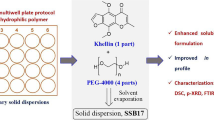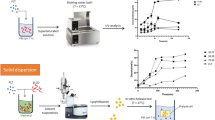Abstract
Betulinic acid (BA), a novel natural product with antimelanoma activity, has poor aqueous solubility (<0.1 μg/mL) and therefore exhibits poor bioavailability. The purpose of this study was to explore the feasibility of preparing BA solid dispersions (BA-SDs) with hydrophilic polymers to enhance the aqueous solubility of BA. Melt-quenched solid dispersions (MQ-SDs) of BA were prepared at various ratios with the hydrophilic polymers including Soluplus, HPMCAS-HF, Kollidon VA64, Kollidon K90, and Eudragit RLPO. BA was found to be miscible in all polymers at a 1:4 (w/w) ratio by modulated differential scanning calorimetry (MDSC). BA/Soluplus MQ-SD exhibited the highest solubility in simulated body fluids followed by BA/Kollidon VA64 MQ-SD. The MQ-SDs of BA/Soluplus, BA/HPMCAS-HF, and BA/Kollidon VA64 were found to be amorphous as indicated by X-ray powder diffraction (XRPD) studies. Fourier transform infra-red (FT-IR) studies indicated molecular interactions between BA and Soluplus. Our preliminary screening of polymers indicates that Soluplus and Kollidon VA64 exhibit the greatest potential to form BA-SDs.







Similar content being viewed by others
References
Kim J, Park EJ. Cytotoxic anticancer candidates from natural resources. Curr Med Chem Anticancer Agents. 2002;2:485–537.
Kessler JH, Mullauer FB, de Roo GM, Medema JP. Broad in-vitro efficacy of plant-derived betulinic acid against cell lines derived from the most prevalent human cancer types. Cancer Lett. 2006;251:132–45.
Kim JY, Koo HM, Kim DS. Development of C-20-modified betulinic acid derivatives as antitumor agents. Bioorg Med Chem Lett. 2001;11:2405–8.
Mullauer FB, Kessler JH, Medema JP. Betulinic acid, a natural compound with potent anticancer effects. Anticancer Drugs. 2010;21(3):215–27.
Mullauer FB, van Bloois L, Daalhuisen JB, Ten Brink MS, Storm G, Medema JP, et al. Betulinic acid delivered in liposomes reduces growth of human lung and colon cancers in mice without causing systemic toxicity. Anticancer Drugs. 2011;22(3):223–33.
Zuco V, Supino R, Righetti SC, Cleris L, Marchesi E, Gambacorti-Passerini C. Selective cytotoxicity of betulinic acid on tumor cell lines, but not on normal cells. Cancer Lett. 2002;175:17–25.
Fulda S, Kroemer G. Targeting mitochondrial apoptosis by betulinic acid in human cancers. Drug Discov Today. 2009;14:885–90.
Fulda S, Scaffidi C, Susin SA, Krammer PH, Kroemer G, Peter ME. Activation of mitochondria and release of mitochondrial apoptogenic factors by betulinic acid. J Biol Chem. 1998;273:33942–8.
Clinical Trials “Evaluation of 20% betulinic acid ointment for treatment of dysplastic nevi (moderate to severe dysplasia)” http://clinicaltrials.gov/show/NCT00346502.
De Clercq E. Highlights in the development of new antiviral agents. Mini Rev Med Chem. 2002;2(2):163–75.
Hashimoto F, Kashiwada Y, Cosentino LM, Chen C, Garrett PE, Lee KH. Anti-AIDS agents-XXVII. Synthesis and anti-HIV activity of betulinic acid and dihydrobetulinic acid derivatives. Bioorg Med Chem. 1997;12:2133–43.
Jäger S, Winkler K, Pfüller U, Scheffler A. Solubility studies of oleanolic acid and betulinic acid in aqueous solutions and plant extracts of Viscum album L. Planta Med. 2007;73(2):157–62.
Claude B, Morin P, Lafosse M, Andre P. Evaluation of apparent formation constants of pentacyclic triterpene acids complexes with derivatized β- and γ-cyclodextrins by reversed phase liquid chromatography. J Chromatogr A. 2004;1049(1–2):37–42.
Dehelean CA, Soica C, Peev C, Ciurlea S, Feflea S, Kasa P. A pharmaco-toxicological evaluation of betulinic acid mixed with hydroxipropilgamma cyclodextrin on in vitro and in vivo models. Farmacia. 2011;59(1):51–9.
Soica CM, Dehelean CA, Peev CI, Coneac G, Gruia AT. Complexation with hydroxypropyl-γcyclodextrin of some pentacyclic triterpenes. Characterisation of their binary products. Farmacia. 2008;56(2):182–90.
Ciurlea SA, Dehelean CA, Ionescu D, Berko S, Csanyi E, Hadaruga DI, et al. A comparative study regarding melanoma activity of betulinic acid on topical ointment vs. systemic nanoemulsion delivery systems. J Agroaliment Process Technol. 2010;16(4):420–6.
Dehelean CA, Feflea S, Ganta S, Amiji M. Anti-angiogenic effects of betulinic acid administered in nanoemulsion formulation using chorioallantoic membrane assay. J Biomed Nanotechnol. 2011;7(2):317–24.
Sharma G, Anabousi S, Ehrhardt C, Ravi Kumar MN. Liposomes as targeted drug delivery systems in the treatment of breast cancer. J Drug Target. 2006;14:301–10.
Janssens S, Van den Mooter G. Review: physical chemistry of solid dispersions. J Pharm Pharmacol. 2009;2009(12):1571–86.
Leuner C, Dressman J. Improving drug solubility for oral delivery using solid dispersions. Eur J Pharm Biopharm. 2000;50:47–60.
Sun Y, Tao J, Zhang GGZ, Yu L. Solubilities of crystalline drugs in polymers: An improved analytical method and comparison of solubilities of indomethacin and nifedipine in PVP, PVP/VA, and PVAc. J Pharm Sci. 2010;99(9):4023–31.
Chiou W, Reigelman S. Pharmaceutical applications of solid dispersion systems. J Pharm Sci. 1971;60:1281–302.
Qian F, Huang J, Zhu Q, Haddadin R, Gawel J, Garmise R, et al. Is a distinctive single Tg a reliable indicator for the homogeneity of amorphous solid dispersion? Int J Pharm. 2010;395:232–5.
Rumondor ACF, Ivanisevic I, Bates S, Alonzo DE, Taylor LS. Evaluation of drug-polymer miscibility in amorphous solid dispersion systems. Pharm Res. 2009;26(11):2523–34.
Hancock BC, Zografi G. Characteristics and significance of the amorphous state in pharmaceutical systems. J Pharm Sci. 1997;86(1):1–12.
Le-Ngoc Vo C, Park C, Lee B-J. Current trends and future perpectives of solid dispersions containing poorly water-soluble drugs. Eur J Pharm Biopharm. 2013;85:799–813.
Andronis V, Zografi G. Molecular mobility of supercooled amorphous indomethacin determined by dynamic mechanical analysis. Pharm Res. 1997;14(4):410–4.
Hancock BC, Shamblin S, Zografi G. Molecular mobility of amorphous pharmaceutical solids below their glass transition temperatures. Pharm Res. 1995;12:799–806.
Bhattacharya S, Suryanarayanan R. Local mobility in amorphous pharmaceuticals—characterization and implications on stability. J Pharm Sci. 2009;98(9):2935–53.
Fekete E, Foldes E, Pukanszky B. Effect of molecular interactions on the miscibility and structure of polymer blends. Eur Poly J. 2005;41:727–36.
Bley H, Fussnegger B, Bodmeier R. Characterization and stability of solid dispersions based on PEG/polymer blends. Int J Pharm. 2010;390(2):165–73.
Forster A, Hempenstall J, Tucker I, Rades T. Selection of exciepients for melt extrusion with poorly water-soluble drugs by solubility parameter calculation and thermal analysis. Int J Pharm. 2001;226:147–61.
Löbmann K, Laitinen R, Strachan C, Rades T, Grohganz H. Aminoacids as co-amorphous stabilizers for poorly water-soluble drugs-Part 2: Molecular interactions. Eur J Pharm Biopharm. 2013;85:882–8.
BASF technical information, Kollidon®VA64 Kollidon®VA64 Fine, August 2011.
Hardung H, Djuric D, Ali S. Combining HME & solubilization: Soluplus®—the solid solution. Drug Del. Tech. 2010; 10(3).
Van Den Mooter G. The use of amorphous solid dispersions: a formulation strategy to overcome poor solubility and dissolution rate. Drug Discov Today: Technol. 2012; e79-85.
Tanno F, Nishiyama Y, Kokubo H, Obara S. Evaluation of hydromellose acetate succinate (HPMCAS) as a carrier in solid dispersions. Drug Dev Ind Pharm. 1999;30:9–17.
Bühler V. Kollidon® Polyvinylpyrrolidone for the pharmaceutical industry, BASF technical infomation, 4th Edition, 1998.
Curatolo W, Nightingale JA, Herbig SM. Utility of hydroxypropylmethylcellulose acetate succinate (HPMCAS-HF) for initiation and maintenance of drug supersaturation in the GL milieu. Pharm Res. 2009;26(6):1419–31.
Folttmann H, Quadir A. Polyvinylpyrrolidone (PVP)—one of the most widely used excipients in pharmaceuticals: an overview. Drug Del Technol. 2008;8(6):22–7.
Hoti E, Qendro G, Censi R, Martino RD, Malaj L. Investigation of the drug stability at the amorphous state using thermal analysis. J. Chem. Chem. Eng. 2012; (6): 646-650.
Newman A, Knipp G, Zografi G. Assessing the performance of amorphous solid dispersions. J Pharm Sci. 2012;101(4):1355–77.
Shamblin SL, Tang X, Chang L, Hancock BC, Pikal MJ. Characterization of the time scales of molecular motion in pharmaceutically important glasses. J Phys Chem B. 1999;103:4113–21.
Brostow W, Chiu R, Kalogeras IM, Vassilikou-Dova A. Prediction of glass transition temperatures: binary blends and copolymers. Mat Let. 2008;62:3152–5.
Gryezke A. Advances in pharmaceutical technology, Chapter 4: Solubility parameters for prediction of drug/polymer miscibility in hot-melt extruded formulations. United Kingdom: John Wiley & Sons Ltd; 2012.
Silverstein RM, Bassler GC, Morril TC. Spectrometric identification of organic compounds. New York: Wiley; 1991. p. 91–131.
Al-Obaidi H, Buckton G. Evaluation of griseofulvin binary and ternary solid dispersions with HPMCAS. AAPS PharmSciTech. 2009;10(4):1172–7.
Shah N, Iyer RM, Mair HJ, Choi DS, Tian H, Diodone R, et al. Improved human bioavailability of vemurafenib, a practically insoluble drug, using an amorphous polymer-stabilized solid dispersion prepared by a solvent-controlled coprecipitation process. J Pharm Sci. 2013;102(3):967–81.
Pirayavaraporn C, Rades T, Tucker IG. Determination of moisture content in relation to thermal behavior and plasticization of Eudragit RLPO. Int J Pharm. 2012;422:68–74.
Sarode AL, Obara S, Tanno FK, Sandhu H, Iyer R, Shah N. Stability assessment of hypromellose acetate succinate (HPMCAS) NF for application in hot melt extrusion (HME). Carbohydr Polym. 2014;101:146–53.
Acknowledgements
We thank Chunhua Hu, PhD, at the Department of Chemistry of New York University for his assistance in acquiring XPRD data and the support by the National Science Foundation under award numbers CRIF/CHE-0840277 and by the NSF MRSEC Program under award number DMR-0820341.
Author information
Authors and Affiliations
Corresponding author
Electronic Supplementary Material
Below is the link to the electronic supplementary material.
ESM 1
(PDF 534 kb)
Rights and permissions
About this article
Cite this article
Yu, M., Ocando, J.E., Trombetta, L. et al. Molecular Interaction Studies of Amorphous Solid Dispersions of the Antimelanoma Agent Betulinic Acid. AAPS PharmSciTech 16, 384–397 (2015). https://doi.org/10.1208/s12249-014-0220-x
Received:
Accepted:
Published:
Issue Date:
DOI: https://doi.org/10.1208/s12249-014-0220-x




